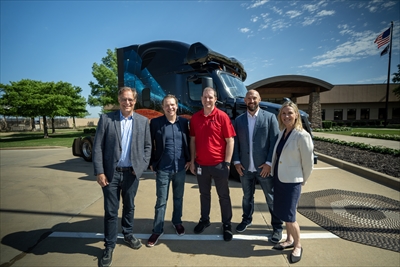CEO Peter Schmidt insists Torc Robotics is well ahead of its competition in the race to commercialize automated driving system technology for Class 8 trucks. The company intends to equip parent company Daimler Truck’s fifth-generation Freightliner Cascadia tractors with Level 4 ADS systems for sale in the U.S. market by 2027.
“That may seem far away, but it really isn’t,” Schmidt told FleetOwner.
The linchpin in that plan is Torc’s new autonomous trucking hub in Hillwood’s AllianceTexas development. Torc will test and validate autonomous vehicles, educate potential customers, and support self-driving trucks. Schmidt and several other executives convened here May 13 for a historic unveiling and tour of this “transformational” facility. “We’re not just opening one more facility, we’re opening a door to the future—the future of autonomous driving,” Schmidt said to the gathered crowd before cutting a ceremonial ribbon.
The open house included insights into hub and fleet operations and autonomous vehicle safety, stops inside the facility’s customer-experience and mission-control centers, a tractor-trailer trade-show unit with a simulator that illustrates how autonomous trucks interpret inputs and make decisions, and, of course, a selfie station with a Torc-powered Cascadia.
“This hub represents more than just logistics,” Torc CCO Andrew Culhane said. “This represents years of relentless planning, prioritization, feedback from industry experts, and tireless efforts from the Torc team here today, as well as across the U.S. At the end of the day, we truly believe this is the realization of our bold vision—in which we see autonomous trucks revolutionizing the freight industry, making it more efficient, more cost-effective, safer, and more reliable for our customers.”
Autonomos hub 1.0
Torc, headquartered in Blacksburg, Virginia, selected the 22,000-sq.-ft. office on 18 acres off Old Denton Road for its strategic proximity to Interstate 35, which passes through Austin and San Antonio before ending up in Port Laredo, the busiest international trade hub in the United States, with 18,000 commercial trucks crossing daily. Additionally, the location is close to several of the largest distribution centers in the country.
“You need to be here if you want to haul freight,” Schmidt said.
“This is the world capital of freight, it’s the end point of our corridor, from I-35 down to Laredo, and it’s just a wonderful place full of businesses, innovators, opportunities—and great partners.”
The rapidly growing area is also centrally located, allowing Torc to eventually redirect autonomous trucks across the U.S. “This is not only strategic to I-35, but also to our Phase 1 network, with how we want to scale and grow,” said Mack Wintin, Torc director of operations.
Torc began running trucks with test loads out of the facility in April and will soon start managing real loads for early adopters like Schneider and C.R. England, who partnered with Torc on previous pilots. Autonomous trucks will pull loaded trailers from Laredo to Torc’s drop-and-hook hub in Fort Worth, where “driver-in” daycabs will tote them to their final destinations. Ten Torc trailers filled the fenced yard when FleetOwner visited. Schmidt said they’re running a handful of Cascadias out of the facility now but soon will have a sizeable fleet.
“This is Version 1.0 of an autonomous hub,” said Carlo Menconi, Torc program manager.
“These trucks are very similar to manual trucks, but the differences are significant. Calibration, localization, inspection, how they impact hub productivity, and how we get data on and off them are all specific to autonomous trucks. So this is where we’re going to figure out what are those best practices, we’re going to document them, and then the efficiencies will be realized through their enhanced productivity and translated back to our customers.”
Mission command
The location will continue to serve as an innovation and remote-assistance center after Daimler begins selling ADS-equipped trucks to customers in 2027. At that point, Torc’s in-vehicle fallback test drivers will transition to mission management or potentially join customer fleets. “We’d like to populate the larger trucking companies out there with folks who understand autonomous trucks and are able to drive them and help with system implementation in a mixed environment,” said John Marinaro, Torc vice president of fleet operations.
Marinaro and Wintin manage deployment on closed courses—like Continental Tire’s Uvalde Proving Grounds and Virginia Tech Transportation Institute’s “Smart Roads”—and on public roadways, with help from Torc’s command-center personnel, who oversee the entire autonomous vehicle ecosystem, from pre-departure preparation to post-trip inspection and everything in between.
Remote assistants provide only indirect support during the mission, Torc emphasized.
“A remote assistant can log into the truck, monitor live camera views, and really understand what the truck is seeing and receiving on the road,” said Collin Robinson, Torc senior product manager. “They’ll have health status, location—a ton of information. And that’s going to help the remote assistant do two things: Support any human interactions with inspectors or law enforcement … and assist the truck in ambiguous or complex driving scenarios.”
